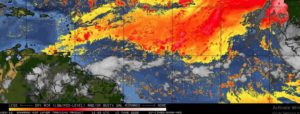In the atmosphere there is a layer of air.
This layer of air is called the Saharan Air Layer (SAL) which is an extremely hot, dry and dust-laden layer of air that originates over the Sahara Desert of North Africa, where it extends from the surface upwards to several kilometres, according to the Trinidad and Tobago Meteorological Service (TTMS).

In a blog it stated that the SAL is fed by strong low to mid-level easterly winds over the desert which pulls sand and dust particles into the atmosphere. This is what causes the dust haze.
TTMS stated, “This layer of dusty, very dry and warm air is pushed westward by the easterly winds and, on reaching the west African coast or eastern Atlantic Ocean, it rides over the cooler, more moist surface air of the Atlantic Ocean, forming what is called an atmospheric inversion layer or boundary: with warm, dry air aloft and cooler, moist air below.”
In an inversion, the temperature increases with height. The inversion boundary between the SAL and the cooler, more humid surface air prevents deep clouds from forming easily due to convection and hence rainfall is suppressed, it stated.
It added, “Convection is the upward movement of warm air or warm air rising. So the inversion boundary acts as a cap and suppresses deep or thick low level cloud formation or what is referred to as convective clouds.
“The SAL has also been observed to suppress the formation and intensification of tropical cyclones and can make tropical waves appear ragged or even disintegrate them due to the mixing of the SAL’s dry air into these weather systems. Why is that? The Saharan air layer typically contain lots of dry air, aerosol dust particles, and strong winds, all of which act against the development of cloud and tropical cyclone formation.
“Once the SAL reaches the Atlantic, the easterly trade winds continue to carry this dust across the Atlantic at the lower and mid-levels, where eventually some of it, oftentimes large pools of it, lands over Trinidad and Tobago and the southern Caribbean. As the SAL moves westward, it maintains the characteristics of warm stable air at its base, and dryness and dustiness throughout its vertical profiles.”
![]()













